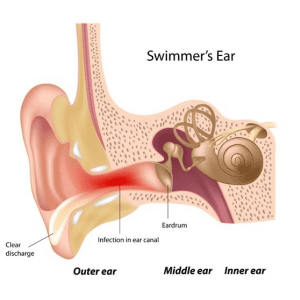Swimmer’s ear (aka otitis externa) is a common infection among kids, frequent swimmers, and those who damage their ears by overcleaning or cleaning with improper instruments. Read more about the symptoms of swimmer’s ear and how to treat it.
Symptoms Of Swimmer’s Ear
Swimmer’s ear starts off with mild discomfort and itching in the ear canal. You may see some slight redness inside the ear and drainage of clear, odorless fluid. Tugging on the ear or pushing the tragus (the little bump in front of the ear) makes it worse.
As swimmer’s ear progresses, redness, itchiness, pain, and fluid discharge increase. It can cause blockage of the ear canal resulting in muffled hearing. When left untreated, it can eventually generate radiating pain that affects the face, neck, and side of the head, plus swollen lymph nodes and fever.
What Is The Difference Between Swimmer’s Ear And A Regular Ear Infection?
Technically, swimmer’s ear (otitis externa) is an ear infection, but when someone is given the diagnosis “ear infection” what is usually meant is middle ear infection (otitis media). Read more about otitis media, the most common type of ear infection, here: Natural Treatments For Ear Infections (Acute Otitis Media) – Dr. Green Mom.

With swimmer’s ear, the ear looks red and is itchy. Clear discharge is often present. Pressing and pulling the ear makes the discomfort worse. In contrast, middle ear infections produce pain that feels deeper in the ear and often worsens while lying down, chewing, or sucking.
When considering the causes of these two types of infection, there are some differences. Middle ear infections are most often associated with viral upper respiratory infections, so other signs of a cold are usually present. Middle ear infections can additionally be caused by swimming in bacteria-infested water. This is different than swimmer’s ear, which can be caused by either clean or dirty water left in the ear canal after swimming and/or by damage to the ear canal.
Prevention Of Swimmer’s Ear
Swimmer’s ear is caused by a bacterial infection in the outer ear canal. It often occurs when water is allowed to stay in the outer ear canal for extended lengths of time, which provides the warm, moist conditions that bacteria thrive in. Keeping the ears dry can help prevent swimmer’s ear.
Ways to keep the ears dry:
- Tip head to each side to drain water from the ears.
- Gently dry the outer ear with a soft towel.
- Gently blow dry the ears if comfortable. Use the lowest setting and hold the blow dryer at least a foot away from the ears.
- Use alcohol-based drying drops in the ears (if the eardrum is intact). Alcohol helps water evaporate more quickly. Over-the-counter ear drops work well, or you can make your own by combining 50% vinegar with 50% rubbing alcohol.
- Wear earplugs or a swim cap while swimming to prevent water from entering the ears.
Excessive cleaning or scratching of the ear canal with cotton swabs, fingers, or other instruments can damage the skin of the ear canal and leave the ear more prone to infection. Avoid putting foreign objects into the ear. If there is an earwax build-up, check in with a doctor or nurse to help with removal.
Natural Treatment Of Swimmer’s Ear
Prompt treatment of swimmer’s ear is important even in mild cases. Avoid swimming and getting ears wet until the swimmer’s ear infection is resolved.
For home treatment of mild swimmer’s ear, make sure that the ear is clean and dry. Apply infection fighting drops to the ear canal if the tympanic membrane is intact.
I recommend using herbal ear drops that fight viral, bacterial, and fungal infections while reducing inflammation, healing tissues, and relieving pain.
Colloidal silver is an excellent second choice. Colloidal silver will take care of the infection but doesn’t provide the inflammation fighting and tissue healing benefits of herbal treatment.
Vitamin C and zinc are beneficial supplements if the infection was caused by damage to the skin. They accelerate tissue healing and fight infection.
See a doctor if mild symptoms of swimmer’s ear don’t begin to resolve within 12 hours of starting treatment. Go to the emergency room if pain is severe, the ear canal appears blocked, and/or fever is present. Conventional treatment usually starts with a topical antibiotic and steroid, but more intensive treatment may be necessary.
Read more: Soothe Ear Pain With This Simple DIY Ear Oil Recipe – Dr. Green Mom
Summary
Swimmer’s ear, aka otitis externa, is a common childhood infection that also occurs in adults. This infection starts with mild itchiness and discomfort of the ear and responds quickly to natural treatment if caught early. As swimmer’s ear advances, the symptoms worsen, and the likelihood that conventional treatment will be necessary increases.
References:
Uzun, L., Dal, T., Kalcıoğlu, M. T., Yürek, M., Açıkgöz, Z. C., & Durmaz, R. (2019). Antimicrobial Activity of Garlic Derivatives on Common Causative Microorganisms of the External Ear Canal and Chronic Middle Ear Infections. Turkish archives of otorhinolaryngology, 57(4), 161–165. https://doi.org/10.5152/tao.2019.4413
Wipperman J. (2014). Otitis externa. Primary care, 41(1), 1–9. https://doi.org/10.1016/j.pop.2013.10.001
McWilliams, C. J., Smith, C. H., & Goldman, R. D. (2012). Acute otitis externa in children. Canadian family physician Medecin de famille canadien, 58(11), 1222–1224.
Carr, A. C., & Maggini, S. (2017). Vitamin C and Immune Function. Nutrients, 9(11), 1211. https://doi.org/10.3390/nu9111211
Pullar, J. M., Carr, A. C., & Vissers, M. (2017). The Roles of Vitamin C in Skin Health. Nutrients, 9(8), 866. https://doi.org/10.3390/nu9080866
Kogan, S., Sood, A., & Garnick, M. S. (2017). Zinc and Wound Healing: A Review of Zinc Physiology and Clinical Applications. Wounds : a compendium of clinical research and practice, 29(4), 102–106








